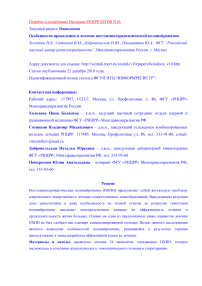Особенности проявления и лечение постхимиотерапевтической полинейропатии
Автор: Холодова Нина Балаевна, Сотников Владимир Михайлович, Добровольская Наталья Юрьевна, Понкратова Юлия Анатольевна
Журнал: Вестник Российского научного центра рентгенорадиологии Минздрава России @vestnik-rncrr
Рубрика: Онкология
Статья в выпуске: 4 т.10, 2010 года.
Бесплатный доступ
Постхимиотерапевтическая полинейропатия (ПХПН) представляет собой актуальную проблему современного лекарственного лечения злокачественных новообразований. Вынужденная редукция дозы цитостатиков и даже необходимость их полной отмены до регрессии симптомов полинейропатии оказывает непосредственное влияние на эффективность лечения и продолжительность жизни больных. Однако ни один из предложенных ранее вариантов лечения ПХПН не был одобрен как стандарт специализированной помощи. Целью данного исследования является выявление особенностей полинейропатии, развившейся в результате терапии цитостатиками, а также разработка эффективной схемы ее лечения. Материалы и методы: проведено лечение 34 пациентов, страдающих ПХПН, которое заключалось в сочетании аллопатического, гомеопатического лечения и гидротерапии. Результаты: у всех больных наблюдалась субъективная и объективная регрессия симптомов полинейропатии, улучшение качества жизни, при необходимости пациенты могли вернуться к прерванному лечению цитостатиками.
Постхимиотерапевтическая полинейропатия, нейротоксичность
Короткий адрес: https://sciup.org/14955214
IDR: 14955214
Список литературы Особенности проявления и лечение постхимиотерапевтической полинейропатии
- Семенова А.И. Кардио-и нейротоксичность противоопухолевых препаратов (патогенез, клиника, профилактика, лечение). Практическая онкология. Т.10. №3. 2009. 168-176
- Arnall DA, Nelson AG, Lopez L, et al. The restorative effects of pulsed infrared light therapy on significant loss of peripheral protective sensation in patients with long-term type 1 and type 2 diabetes mellitus. Acta Diabetol. 2006;43:26-33.
- Balducci S, Iacobellis G, Parisi L, et al. Exercise training can modify the natural history of diabetic peripheral neuropathy. J Diabetes Complications. 2006;20:216-223.
- Benoit E, Brienza S, Dubois JM. Oxaliplatin, an anticancer agent that affects both Na+ and K+ channels in frog peripheral myelinated axons. Gen Physiol Biophys 2006;25:263-276.
- Dunlap B, Paice JA. Chemotherapy-indused periferal neuropathy: a need for standartization in measurement. J Support Oncol. 2006;4:389-399.
- Forst T, Nguyen M, Forst S, et al. Impact of low frequency transcutaneous electrical nerve stimulation on symptomatic diabetic neuropathy using the new salutaris device. Diabetes Nutr Metab. 2004;17:163-168.
- Hammack JE, Michalak JC, Loprinzi CL, et al. Phase III evaluation of nortriptyline for alleviation of symptoms of cisplatinuminduced peripheral neuropathy. Pain 2002;98:195-203.
- Kannarkat G, Lasher EE, Schiff D. Neurologic complications of chemotherapy agenys. Curr Opin Neurol. 2007;20:719-725.
- Kautio AL, Haanpaa M, Saarto T, Kalso E. Amitriptyline in the treatment of chemotherapy-induced neuropathic symptoms. J Pain Symptom Manage 2008;35:31-39.
- Lindeman E, Leffers P, Spaans F, et al. Strength training in patients with myotonic dystrophy and hereditary motor and sensory neuropathy: a randomized clinical trial. Arch Phys Med Rehabil. 1995;76:612-620.
- Maestri A, De Pasquale Ceratti A, Cundari S, et al. A pilot study on the effect of acetyl-L-carnitine in paclitaxel and cisplatininduced peripheral neuropathy. Tumori. 2005;91:135-138.
- Meier T, Wasner G, Faust M, et al. Efficacy of lidocaine patch 5% in the treatment of focal peripheral neuropathic Pain syndromes: a randomized, double-blind, placebo-controlled study. Pain 2003;106:151-158.
- Michael D. Stubblefield, MD; Harold J et al. NCCN Task Force Report: Management of Neuropathy in Cancer. Journal of the National Comprehensive Cancer Network. September 2009; Volume 7; Supplement 5: S3.onal
- Paice JA. Chemotherapy-indused periferal neuropathy: the dangerous but understudied syndrome. Pain management SIG Newsletter. 2007;17(1). Доступен по http:/onsopcontent.ons.org/Publications/Sig/Newsletters/pm/pm17.1.htlm.
- Paice JA. Periferal neuropathy: experimental findings, clinical approaches. J Support Oncol. 2005:5:61-63.
- Quilici S, Chancellor J, Lothgren M, et al. Meta-analysis of duloxetine vs. pregabalin and gabapentin in the treatment of diabetic peripheral neuropathic pain. BMC Neurol 2009;9:6.
- Rao RD, Michalak JC, Sloan JA, et al. Efficacy of gabapentin in the management of chemotherapy-induced peripheral neuropathy: a phase 3 randomized, double-blind, placebo-controlled, crossover trial (N00C3). Cancer 2007;110:2110-2118.
- Raskin J, Pritchett YL, Wang F, et al. A double-blind, randomized multicenter trial comparing duloxetine with placebo in the management of diabetic peripheral neuropathic pain. Pain Med 2005;6:346-356.
- Richardson JK, Sandman D, Vela S. A focused exercise regimen improves clinical measures of balance in patients with peripheral neuropathy. Arch Phys Med Rehabil. 2001;82:205-209.
- Stillman M, Cata GP. Management of chemitherapy indused periferal neuropathy. Cerr Pain Headache Rep 2006; 10:289-287.
- Tulub AA, Stefanov VE. Cisplatin stops tubulin assembly into clinical and electrophysiological studies. Ann Neurol microtubules. A new insight into the mechanism of antitumor activity of platinum complexes. Int J Biol Macromol 2001;28:191-198.
- Wernicke JF, Pritchett YL, D'Souza DN, et al. A randomized controlled trial of duloxetine in diabetic peripheral neuropathic pain. Neurology 2006;67:1411-1420.
- Wong R, Sagar S. Acupuncture treatment for chemotherapyinduced peripheral neuropathy-a case series. Acupunct Med. 2006;24:87-91


